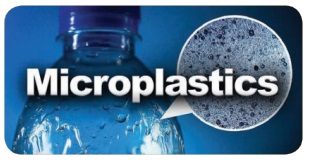Science : Chapter 13 : Water
TEXTBOOK EXERCISES
I. Choose the correct answer.
1. Water changes to ice at
a) 0ºC
b) 100ºC
c) 102ºC
d) 98ºC
[Answer: (a) 0°C]
2. Solubility of carbon dioxide in water is high when the
a) pressure is low
b) pressure is high
c) temperature is high
d) None of the above
[Answer: (b) pressure is high]
3. The gas collected at the cathode on electrolysis of water is
a) oxygen
b) hydrogen
c) nitrogen
d) carbon dioxide
[Answer: (b) hydrogen]
4. Which of the following is a water pollutant?
a) Lead
b) Alum
c) Oxygen
d) Chlorine
[Answer: (a) Lead]
5. Permanent hardness of water is due to the presence of __________
a) sulphates and chlorides
b) dust particles
c) carbonates and bicarbonates
d) other soluble particles
[Answer: (a) Sulphates and Chlorides]
II. Fill in the blanks.
1. Water is colourless, odourless and tasteless.
2. The boiling point of water is 100°C.
3. Temporary hardness of water can be removed by boiling of water.
4. The density of water is maximum at 4°C.
5. Loading speeds up the process of dihydrogen monoxide H2O.
III. State true or false. If false, correct the statement
1. Sewage should be treated well before being discharged it into water bodies. [Answer: True.]
2. Sea water is suitable for irrigation as it contains dissolved salts. [Answer: False.]
Correct statement: Sea water is not suitable for irrigation as it has high salinity.
3. Excessive use of chemical fertilizers depletes the soil and causes water pollution. [Answer: True.]
4. The density of water will not change at all temperature? [Answer: False.]
Correct statement: The density of water is different at different temperatures.
5. Soap lathers well in hard water. [Answer: False.]
Correct statement: Soap lathers well in soft water.
IV. Match the following.
1. Universal solvent – Water pollutant
2. Hard water – Kills germs
3. Boiling – Ozonisation
4. Sterilization – Water
5. Sewage – Stomach ailments
Answer:
1. Universal solvent – Water
2. Hard water – Stomach ailments
3. Boiling – Kills germs
4. Sterilization – Ozonisation
5. Sewage – Water Pollutant
V. Give reasons for the following.
1. Alum is added to water in sedimentation tanks.
Reason :
(i) Chemical substance potash alum is added to water to speed up the process of sedimentation.
(ii) This process is called loading.
(iii) The particles of potash alum combine with the suspended impurities and make them settle down at a faster rate.
2. Water is a universal solvent.
Reason :
(i) Water has a unique property to dissolve more substances than any other liquids.
(ii) It can dissolve solids such as salt and sugar, liquids such as honey and milk and gases such as oxygen and carbon dioxide in it.
(iii) Water can dissolve more number of substances than any other solvent.
(iv) Therefore, it is called as universal solvent.
3. Ice floats on water.
Reason:
(i) This is because ice is lighter than water.
(ii) It means that the density of ice is lower than that of water.
(iii) Since ice is a bad conductor of heat it does not allow heat to pass through it.
(iv) So, the water below the ice remains in liquid form, where most of the aquatic life lives.
4. Aquatic animals can breathe in water.
Reason :
(i) Air dissolved in water is important for the aquatic animals to survive.
(ii) Aquatic animals extracts the oxygen form the water and expels water.
(iii) They can breathe in water only through the dissolved oxygen present in water.
5. Sea water is unfit for drinking.
Reason :
(i) Every litre of sea water contains 35 grams of dissolved salts most commonly known as sodium chloride (NaCl).
(ii) Such water is called saline water.
(iii) It is not suitable for drinking and is said to be non-potable water.
6. Hard water is not good for washing utensils.
Reason :
Hard water damages the utensils and containers in which it is stored and forms a hard layer.
VI. Define the following.
1. Freezing point
Answer: The temperature at which a liquid turns into solid when cooled is known as freezing point. The freezing point of water is 0°C.
2. Boiling point
Answer: The temperature at which water boils and changes to steam is called as boiling point. The boiling point of water is 100°C at atmospheric pressure.
3. Specific heat capacity
Answer: Amount of heat that is needed to raise the temperature of a unit mass of a substance by 1 °C is called specific heat capacity.
4. Latent heat of fusion
Answer: The amount of heat energy required by ice to change into water is called latent heat of fusion.
5. Potable water
Answer: The water suitable for drinking is called potable water.
VII. Answer in brief.
1. Name the gas evolved at cathode and anode when water is electrolysed. State their ratio by volume.
Answer:
(i) The gas which is evolved at cathode : Hydrogen (H2).
(ii) The gas which is evolved at anode : Oxygen (O2)
(iii) The ratio of H2 and O2 = 2 : 1.
2. State the importance of dissolved oxygen and carbon dioxide in water.
Answer:
(i) Fish extracts the oxygen from the water and expels water through the gills. Fish can survive in water only through the dissolved oxygen present in water.
(ii) Aquatic plants make use of dissolved carbon dioxide for photosynthesis.
(Hi) Carbon dioxide dissolved in water reacts with limestone to form calcium bicarbonate.
(iv) Marine organisms such as snails, oysters, etc., extract calcium carbonate from calcium bicarbonate to build their shells.
3. What are the causes of temporary hardness and permanent hardness of water?
Answer:
(i) Temporary hardness is due to the presence of carbonate and bicarbonate salts of calcium and magnesium.
(ii) Permanent hardness is due to the presence of chloride and sulphate salts of calcium and magnesium.
4. Explain specific latent heat of vaporization of water.
Answer:
(i) When water attains the temperature of 100°C, it starts changing its state from liquid to gaseous state, however, the temperature of water does not rise above 100°C.
(ii) It is because the heat energy supplied only changes the state of the boiling water.
(iii) This heat energy is stored in steam and is commonly called latent heat of vaporization of steam.
5. What are the methods of removing hardness of water?
Answer:
(i) Boiling : Temporary hardness is easily removed from water by boiling.
(ii) Adding washing soda : Washing soda is used to remove permanent hardness of water.
(iii) Ion-exchange : This converts hard water into soft water.
(iv) Distillation : Temporary and permanent hardness both can be removed by the method of distillation.
VIII. Answer in detail.
1. How is water purified at a water purification plant?
Answer: In conventional water treatment plant, water is subjected to different process. They are :
Sedimentation :
i) Water from lakes or rivers is collected in large sedimentation tanks.
(ii) There, it is allowed to stand undisturbed so that suspended impurities settle down at the bottom of the tank.
(iii) Sometimes, a chemical substance such as potash alum is added to water to speed up the process of sedimentation, this is called loading.
(iv) The particles of potash alum combine with the suspended impurities and make them settle down at a faster rate.
Filtration :
(i) Water from the sedimentation tanks is then pumped to the filtration tanks.
(ii) Filtration tanks contain filter beds made up of gravel, sand, pebbles, activated charcoal and concrete.
(iii) Water passes through these layers and becomes free from any remaining dissolved or suspended impurities completely.

Sterilisation :
(i) The filtered water is treated chemically to remove the remaining germs or bacteria, this process is called sterilisation.
(ii) The chemicals that are used in this process are chlorine and ozone.
(iii) The process of adding chlorine in adequate amounts to water is called chlorination.
(iv) The water from filtration tanks is pumped into chlorination tanks, where chlorine is added to remove harmful bacteria and other germs.
(v) Ozonisation is a process in which water is treated with ozone gas to kill the germs present in it.
(vi) The sterilisation of water can also be done by exposing it to air and sunlight.
(vii) Oxygen from the air and sunlight destroy the germs present in water.
(viii) Aeration is the process in which air under pressure is blown into filtered water, this also helps to kill the germs.
2. What is permanent hardness of water? How can it be removed?
Answer: The hardness due to the presence of chloride and sulphate salts of calcium and magnesium is known as permanent hardness of water.
Removal of hardness :
Adding washing soda :
(i) Washing soda is used to remove permanent hardness of water.
(ii) It converts chlorides and sulphates into insoluble carbonates.
(iii) These insoluble carbonates are removed by filtration.
Distillation :
(i) Temporary and permanent hardness both can be removed by the method of distillation.
(ii) The water obtained after distillation is called distilled water.
(iii) It is the purest form of water.
3. What is Electrolysis? Explain the electrolysis of water.
Answer: The process of breaking down of water molecules by the passage of electric current is known as electrolysis of water.
Electrolysis of Water:
(i) A glass beaker is fixed with two carbon electrodes and it is filled with water up to one third of its volume.
(ii) The positive carbon electrode acts as anode and the negative carbon electrode acts as cathode.
(iii) Two test tubes are placed on the electrodes.
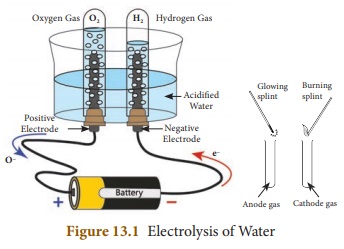
(iv) The electrodes are connected to a battery and current is passed until the test tubes are filled with a particular gas.
(v) If the gas collected is tested using a burning splint we can notice that the gas in cathode side burns with a popping sound when the burning splint is brought near the mouth of the test tube.
(vi) This property is usually shown by hydrogen gas and so it is confirmed that the gas inside the test tube is hydrogen.
(vii) The burning splint placed near the anode side burns more brightly confirming that it is oxygen gas. This experiment shows that water is made up of hydrogen and oxygen.
(viii) The ratio of hydrogen and oxygen is 2:1. Hence, for every two volumes of hydrogen collected at the cathode, there is one volume of oxygen collected at the anode.
2H2O Electrolysis→ 2H2 + O
4. Explain the different ways by which water gets polluted.
Answer:
Domestic Sewage :
Untreated sewage contains impurities such as organic matter from food waste, toxic chemicals from household products and it may also contain disease-causing microbes.
Domestic waste and plastics :
Plastics block drains spreading vector borne diseases such as malaria and dengue. Waste in water bodies negatively impact aquatic life.
Agricultural activities :
(i) Fertilizers, pesticides and insecticides used in agriculture can dissolve in rainwater and flow into water bodies such as rivers and lakes.
(ii) This causes an excess of nutrients such as nitrates and phosphates as well as toxic chemicals into the water bodies and they can be harmful to aquatic life.
Industrial waste :
(i) Many industries release toxic waste such as lead, mercury, cyanides, cadmium, etc.
(ii) If this waste is unregulated and is released into water bodies, it negatively impacts humans, plants, animals and aquatic life.
Oil spills :
Oil spills cause water pollution which is harmful to aquatic life.
Thermal pollution :
Water used for cooling purposes is discharged back to a river or to original water source at a raised temperature and sometimes with chemicals. This rise in temperature decreases the amount of oxygen dissolved in water which adversely affects the aquatic life.
Student Activities
Activity 1
Take some anhydrous copper (II) sulphate powder and place it in a watch glass. Add water drop by drop to the anhydrous copper sulphate. Do you notice any colour change in the powder? You can notice the powder turning blue. It is a test for water.
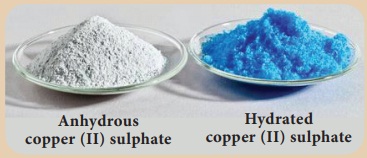
Answer:
(i) The reaction between anhydrous copper (II) sulphate and water is used as a test for water.
(ii) The white solid turns blue in the presence of water.
Activity 2
Fill a trough with water. Cut a small piece of sodium with a knife and carefully drop it in the water. Sodium reacts with water and darts across the surface of water. A flame produced is also seen near the surface.
Activity 3
Place a sample of tap water on a clean watch glass and place it over a beaker containing water, as shown in the figure. Boil the water in the beaker. When all the water has evaporated from the watch glass, remove it from the burner and let it cool. What do you see on the watch glass?
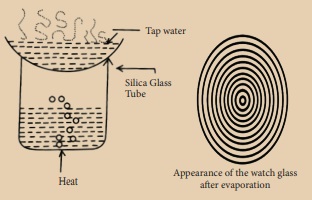
Answer:
(i) We can observe a number of concentric rings of solid matter deposited on the watch glass.
(ii) These are the dissolved solids left behind after the evaporation of water. Salts, minerals and impurities are the solids dissolved in water.
Activity 4
Take a beaker and fill it half with fresh tap water and heat it. You will see small bubbles appearing on the side of the beaker long before the water reaches its boiling point. These bubbles are oxygen gas dissolved in water.
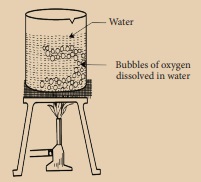
Activity 5
Take two pots with similar plants. Water one of the plants with tap water and the other with sea water. Record your findings and note the difference observed.
Answer:
Observation :
(i) Due to the high salinity of sea water, the plant starts to droop.
(ii) The plant which is watered with tap water grows well.
Activity 6
Take samples of water from different sources (like a tube well, a lake, a pond or a river) and pour equal quantities of each sample of water into different test tubes. Measure the height of water in each test tube with a scale. Add one or two drops of liquid soap to each test tube.
Shake each test tube five times and observe the height of the lather in each sample. Record your observations in the table. Which water is soft? Which water is hard? Can you say why?
Answer:
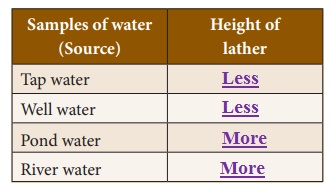
Samples of water (Source) : Height of lather
1. Tap water : Less
2. Well water : Less
3. Pond water : More
4. River water : More
Which water is soft? Can you say why?
Answer:
(i) Pond and river water are considered as soft due to presence of very small quantities of salts.
(ii) Salts are present in very small quantities .
Which water is hard? Can you say why?
Answer: Tap and well water are considered as hard due to presence of large quantity of minerals and salts .
Activity 7
Take a shampoo, shower gel or other product you think might have micro-beads in it. Mix two tablespoons of this in a glass of water and stir it well. Pour the water in a black t-shirt filtering the micro-beads out.

Henry Cavendish was a British philosopher, scientist, chemist, and physicist. Cavendish is noted for his discovery of hydrogen. He called it inflammable air. He mixed metals with strong acids and created hydrogen. He created carbon dioxide also by combining metals with strong bases.

Pure water has the following physical properties.
• Pure water boils at 100° C at one atmospheric pressure.
• Pure water freezes at exactly 0°C at one atmospheric pressure.
• Pure water has a density of 1 gm/cm3
When the skaters move on ice,they exert pressure on it. This pressure lowers the freezing point. As a result, the ice melts underneaththe skate and allows the skaters to glide across the ice with little effort. When the skaters move forward, pressure is decreased and the water re-freezes to ice again.

The freshness of fish and meat can be maintained by placing them in contact with ice. With its larger latent heat, ice is able to absorba large quantity of heat from the fish as it melts. Thus, food can be kept at a low temperature for an extended period of time.
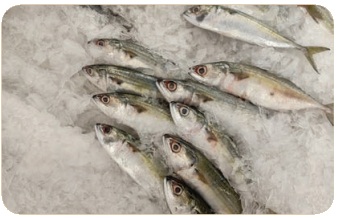
Copper does not react with water at any temperature. That is why it is used for making pipes and boilers.
Tap water, river water and well water contain dissolved solid but rainwater and distilled water do not contain dissolved solids. Hence concentric rings are not formed in the rain water and distilled water after evaporation.
The salinity of water is more in the Dead sea. It is actually a salt lake as it has a single source of water and is not connected to the ocean. It is landlocked and this causes the water to evaporate. This has led to a steady increase in its degree of salinity. Now the salinity is so high such that the marine life cannot survive in it. This is why it is called the Dead sea.

Every year 4. 6 million childrendie due to diarrhea. Access to clean water improves hygiene and health.
RO purifiers are the purifiers that can remove the dissolved impurities and germs. They also improve the taste of water. RO standsfor the name of the technology, ‘reverse osmosis’, used in these purifiers. Some RO purifiers also have a UV (ultraviolet) unit that destroys the germs present in water.
Distilled water and boiled water have no taste. The pleasant taste of drinking water is due to the presence of dissolved substances which include air, carbon dioxide and minerals.
About 90% of the available surface water has already been tapped mainly for agriculture and irrigation.
The largest source of wate pollution in India is untreated sewage. On an average, a person uses 135 litres of water per day for washing clothes, cooking, bathing, etc.

Plastic sheets are used in agriculture to grow vegetables. At the end of the season, these plastic sheets are ploughed back into thesoil. The plastic sheets break into tiny pieces and get eaten by earth worms, which is harmful to their health and that of soil.
Micro-plastics can be found in almost every freshwater source. They have been found from the freezing waters of the Arctic andAntarctic to the bottom of the deep-sea floor upto 5,000 meters deep. Micro-plastics have been found in bottled water and tap water around the world.
